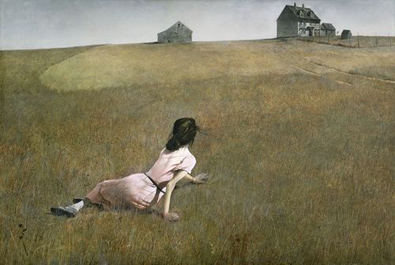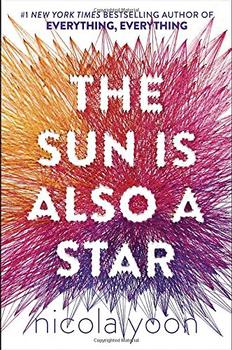 Andrew Wyeth's painting Christina's World, the subject of A Piece of the World, was initially met with little fanfare, and its critical reception was lackluster. Nevertheless, the painting, which features Christina Olson reaching toward her home in the distance, was purchased during its first showing at a New York Gallery in 1948 by Alfred Barr, the founding director of the Museum of Modern Art (MoMA). Today it is one of MoMA's most admired exhibits and has become a well-known representation of American art. The painting has been loaned out only once since its purchase when it was shown for two days in 2009 at Chadds Ford, PA, Wyeth's hometown, in memoriam of the artist.
Andrew Wyeth's painting Christina's World, the subject of A Piece of the World, was initially met with little fanfare, and its critical reception was lackluster. Nevertheless, the painting, which features Christina Olson reaching toward her home in the distance, was purchased during its first showing at a New York Gallery in 1948 by Alfred Barr, the founding director of the Museum of Modern Art (MoMA). Today it is one of MoMA's most admired exhibits and has become a well-known representation of American art. The painting has been loaned out only once since its purchase when it was shown for two days in 2009 at Chadds Ford, PA, Wyeth's hometown, in memoriam of the artist.
 Nicola Yoon's The Sun Is Also a Star is an example of a circadian novel where the main action (except flashbacks, for instance) takes place all on one day. The most celebrated example is James Joyce's Ulysses (1922), set in 1904 Dublin on what has come to be known as "Bloomsday," June 16th. The protagonist, Leopold Bloom, mostly wanders the streets of his city: attending a funeral, arguing in a pub, and so on. The Sixteenth of June (2014) by Maya Lang recreates the format of Ulysses in a near-contemporary story set in Philadelphia.
Nicola Yoon's The Sun Is Also a Star is an example of a circadian novel where the main action (except flashbacks, for instance) takes place all on one day. The most celebrated example is James Joyce's Ulysses (1922), set in 1904 Dublin on what has come to be known as "Bloomsday," June 16th. The protagonist, Leopold Bloom, mostly wanders the streets of his city: attending a funeral, arguing in a pub, and so on. The Sixteenth of June (2014) by Maya Lang recreates the format of Ulysses in a near-contemporary story set in Philadelphia.
 Mary Miller's Always Happy Hour is set in the south, but many will see it as something other than true southern fiction. The protagonists are too internalized, too walled off from the southerness – the land, the people, the ethos of pride, racial discord, and defeat – that is the beating heart of most great southern fiction; that is to say the forces that drive everything from regional pride to politics to art. More typical southern writers touch on some if not all of those forces, and create such
Mary Miller's Always Happy Hour is set in the south, but many will see it as something other than true southern fiction. The protagonists are too internalized, too walled off from the southerness – the land, the people, the ethos of pride, racial discord, and defeat – that is the beating heart of most great southern fiction; that is to say the forces that drive everything from regional pride to politics to art. More typical southern writers touch on some if not all of those forces, and create such
Each time BookBrowse reviews a book we also go "beyond the book" to explore a related topic. Here is a recommended reading list of 10 epistolary novels - that is to say books written in the form of letters or journal entries - which we wrote to support our review of Letters to the Lost by Iona Grey:
Epistolary novels are not new – Bram Stoker's Dracula, for example, was published in 1879, and Mary Shelley's Frankenstein even earlier, in 1818. The form, which is not limited to letters, (nor to horror novels!) also includes journal entries, newspaper clippings, emails, and other forms of correspondence. Perhaps its appeal lies in its inherent hush-hush nature: the main character seems to share a secret with the reader, something meant for his or her own eyes, or one other beloved's eyes. The reader feels lucky to be included in the communication. Whatever the reason, the epistolary novel continues to be written, and enjoyed. Iona Grey's debut novel, Letters to the Lost, is one such novel. Here are 10 others. It is not an exhaustive list, by any means, but a good place to begin investigating this intriguing form.
Dear BookBrowsers,
Each book we feature in the BookBrowse Review (our twice-monthly membership magazine) is backed by a review and an excerpt, and often a reading guide and author interview. In addition, we always include a "Beyond the Book" article. In fact, these pithy features are so popular that a significant number of members tell us they look forward to reading them first.
To feed the geek in you, we feature a sampling of recent Beyond the Book articles in this special edition. They explore a gamut of topics to satisfy a wide range of interests and are representative of the kind of content we love to dig into. We pack our reading recommendations with just that extra touch of noteworthy content because we know that you too love the excitement of discovering something you never knew before.
 Each time BookBrowse reviews a book we also go "beyond the book" to explore a related topic. Last week we reviewed A Prison in Malta, the first in a new 16th century mystery series by Phillip DePoy which introduces a sleuth to appeal to mystery, historical fiction and literary aficionados alike, none other than playwright Christopher Marlowe (who, in all likelihood, did do to a fair amount of real-life spying for Queen Elizabeth.)
Each time BookBrowse reviews a book we also go "beyond the book" to explore a related topic. Last week we reviewed A Prison in Malta, the first in a new 16th century mystery series by Phillip DePoy which introduces a sleuth to appeal to mystery, historical fiction and literary aficionados alike, none other than playwright Christopher Marlowe (who, in all likelihood, did do to a fair amount of real-life spying for Queen Elizabeth.)
Going "beyond the book" our reviewer James Broderick eruditely explores the 400-year-old question - did Shakespeare write his plays or were they written by someone else? And was that someone Christopher Marlowe? If you've found the "Shakespeare authorship" question a tad dry, even irrelevant, or perhaps didn't even know there was a question to resolve, be prepared to be happily entertained and intrigued as James, in a mere 700 words, eloquently gets to the gist of a debate that has spawned dozens of books: